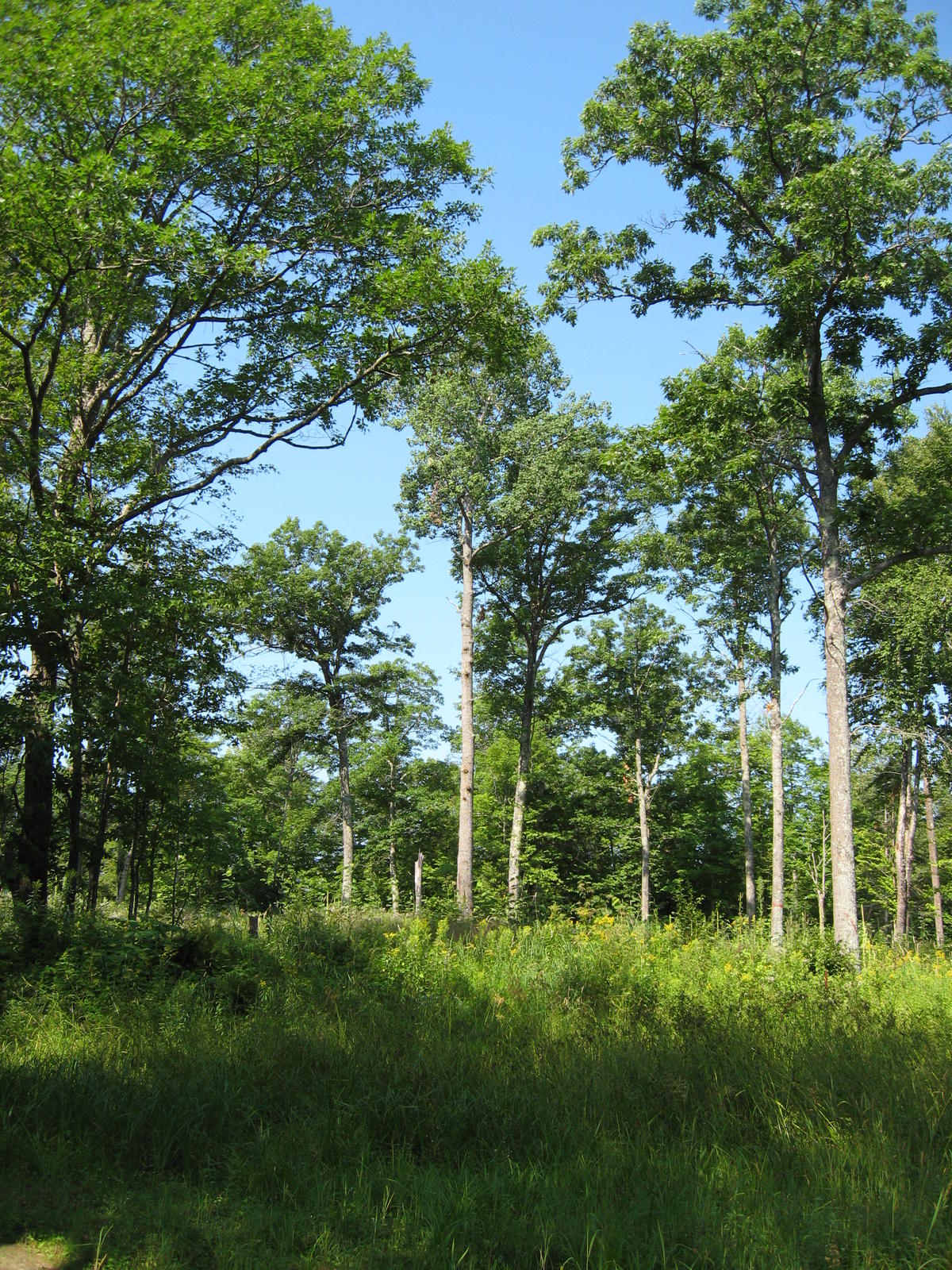Overview
This case study describes regeneration results from adjacent two step oak shelterwood timber harvests. Both of these sites have similar soil types, pre-harvest overstory and understory conditions, and Native Plant Communities (NPC’s). The variability in these sites lies in the season of harvest and degree of soil scarification during harvest. Stand 1 (MN CSA stand ID: t05026w1170193) was harvested when factors for oak regeneration were very favorable. A fall shelterwood establishment cut occured during a good oak seed year, and a full tree harvest system resulted in excellent ground scarification. These factors resulted in a large catch of oak regenerants the following year. Stand 2 (MN CSA stand ID: t05026w1170204) had less favorable conditions for oak regeneration. Due to consecutive wet summers and falls the stand was winter harvested which resulted in less ground scarification than occurred on Stand 2.
The oak cover type found on state lands in Aitkin County is heavily skewed to an age class of 80-110 years. The forest management plans that cover these stands calls for a normal rotation age of 80 years with a maximum rotation age of 120 years. As the state starts to look to regenerate oak on these sites I am hoping to help define how specific the State must be on our timber sale specifications, in regard to harvest timing and degree of soil scarification, to ensure an adequate chance of regenerating oak.
Silviculture Objective(s)
The objective was to conduct a two-step shelterwood harvest that would increase oak presence in a future mixed hardwood stand. Maintaining and increasing the oak cover-type and oak as a component of other cover-types is often an objective identified in MNDNR Section Forest Resource Management Plans (SFRMP).
Pre-treatment stand description and condition
Stand establishment and management history:
Both stands were in a similar growth stage and had similar overstory conditions at the time of harvest.
These stands had been thinned in the mid-1990’s using a marked crop tree release harvest which included the removal of some pockets of aspen and birch.
Pre-treatment species composition:
Prior to the shelterwood establishment cut, Stands 1 and 2 were similar in overstory composition with 23.2 and 22 cords per acre respectively. Dominant species included northern red oak, basswood, sugar maple, aspen, and paper birch (Table 1).
Table 1: Pre-harvest overstory composition in cords per acre by species.
| Species | Stand 1 (cords per acre) | Stand 2 (cords per acre) |
| Sugar maple | 3.2 | 4.5 |
| N. red oak | 5.8 | 7.3 |
| Basswood | 5.5 | 4.1 |
| Aspen | 5.2 | 2.5 |
| Red maple | 0.5 | 0.5 |
| Paper birch | 1.5 | 2.1 |
| Black ash | 1 | 0.5 |
| Yellow birch | 0.5 | 0.5 |
| TOTAL | 23.2 | 22 |
Historic understory data was limited, but the inventory data indicated northern hardwood species (CSA species code 20) at a density of 1,751-2,250 (CSA regen code 4). For this case study we assumed pre-harvest regeneration dominated by sugar maple at 2,000 stems per acre.
Pre-treatment growth and stocking:
Pre-harvest basal area was around 90 for both of the stands. At the time of harvest the stands were transitioning. The initial cohort of aspen and birch were declining, and sugar maple was established in the understory.
Pre-treatment forest health issues:
None noted.
Landowner objectives/situation:
While specific objectives vary from parcel to parcel, lands under the administration of DNR-Forestry are managed in alignment with Section Forest Resource Managment Plans (SFRMP) to ensure that state forest management activities meet statewide goals for ecological protection, timber production, and cultural/recreational values. The DNR assembles teams from the Divisions of Forestry, Fish & Wildlife, and Ecological & Water Resources who work with partners and the public to develop SFRMPs.
Silviculture Prescription
A similar prescription was planned for each of the harvest sites and included using a two-step shelterwood to move a transitional northern hardwood stand to a young mixed hardwood stand with increased oak abundance.
The desired future condition for boths stands included a healthy stand of regenerating hardwoods, primarily consisting of red oak and basswood with components of other northern hardwood species.
Regeneration goals were 500 stems per acre of oak with a mix of other hardwood species present. The first treatment, or establishment cut, was marked to reserve approximately 30-40 BA in the overstory, reserving good quality oak, all yellow birch, and scattered basswood and sugar maple. Scattered aspen trees present in the stand were also reserved. Any clones of bigtooth aspen were harvested to retain this species in stand. Den trees were reserved. Full tree or tree length skidding was required on both of the harvests. Dry summer or fall harvest were highly recommended but frozen conditions were allowed, with snow free conditions recommended.
If regeneration standards were not met within the first 3 years post-harvest, some site scarification using an anchor chain or other piece of equipment was tentatively planned. Overstory removal was planned 4-5 years post-harvest depending on regeneration numbers.
What actually happened during the treatment
Stand 1 was harvested in the fall of 2012 under very favorable conditions for oak regeneration. The summer and fall of 2012 was very dry, so equipment was able to access the site without rutting or compaction issues. The stand was full tree skidded with the slash lopped and scattered over the site. Site soil scarification covered approximately 75% of the stand. The acorn crop was heavy and seeds were actively dropping during harvest activities. Residual basal area was approximately 40 square feet per acre in this stand.
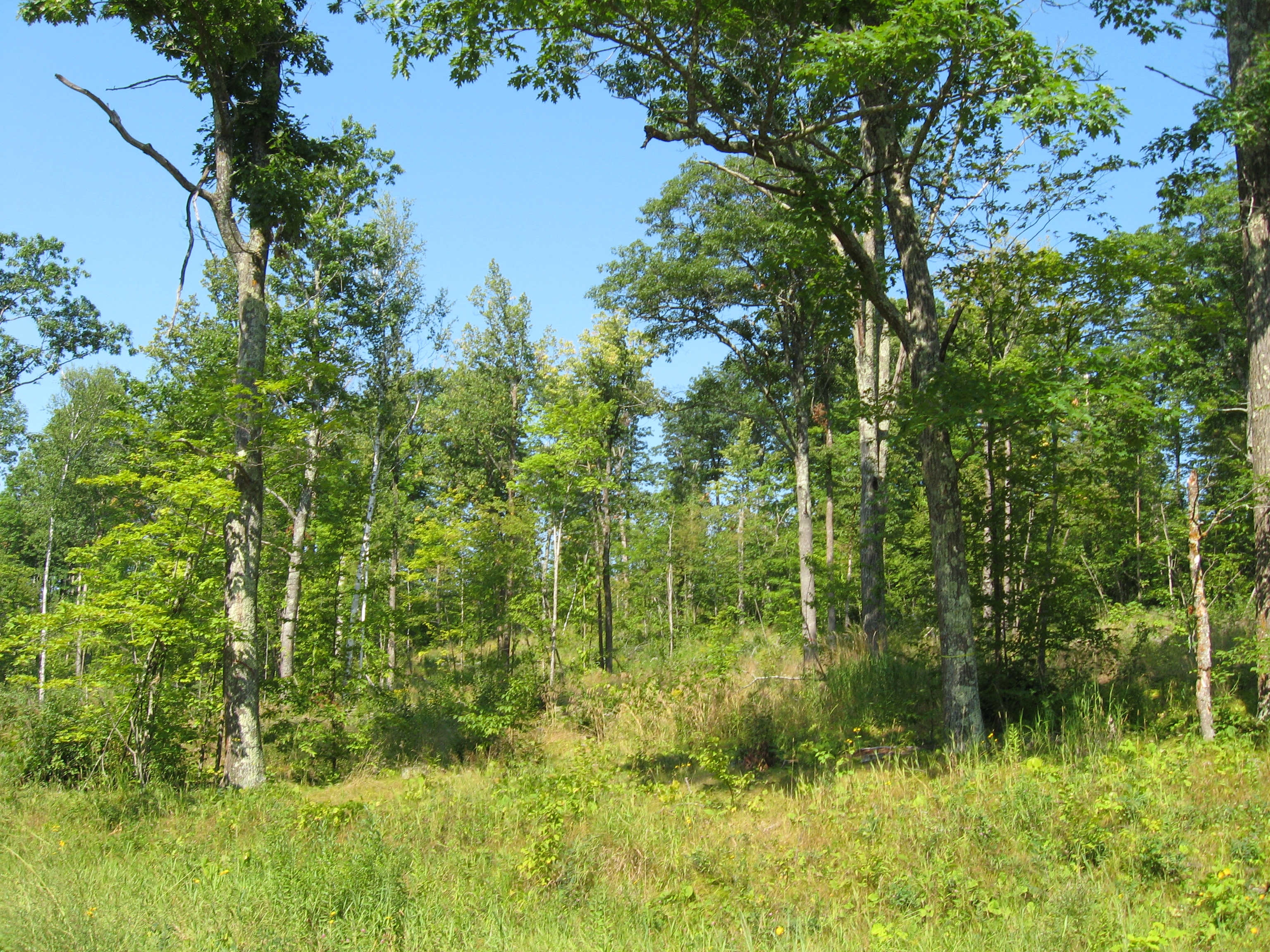
Figure 1: 1 year post harvest
Stand 2 was harvested in the winters of 2016-17 and 2017-18. Wet conditions in the summer and fall prevented operations during the preferred season, and the permit was set to expire May of 2018. The stand was primarily harvested in early winter, before snow had become very deep, but site scarification was limited to primary skid trails. The site was tree length skidded with slash lopped and scattered over the site. Based on recollections, the oak acorn crop was low the fall of 2017, but no data exists to back up this observation. Residual basal area was approximately 30 square feet per acre in this stand.
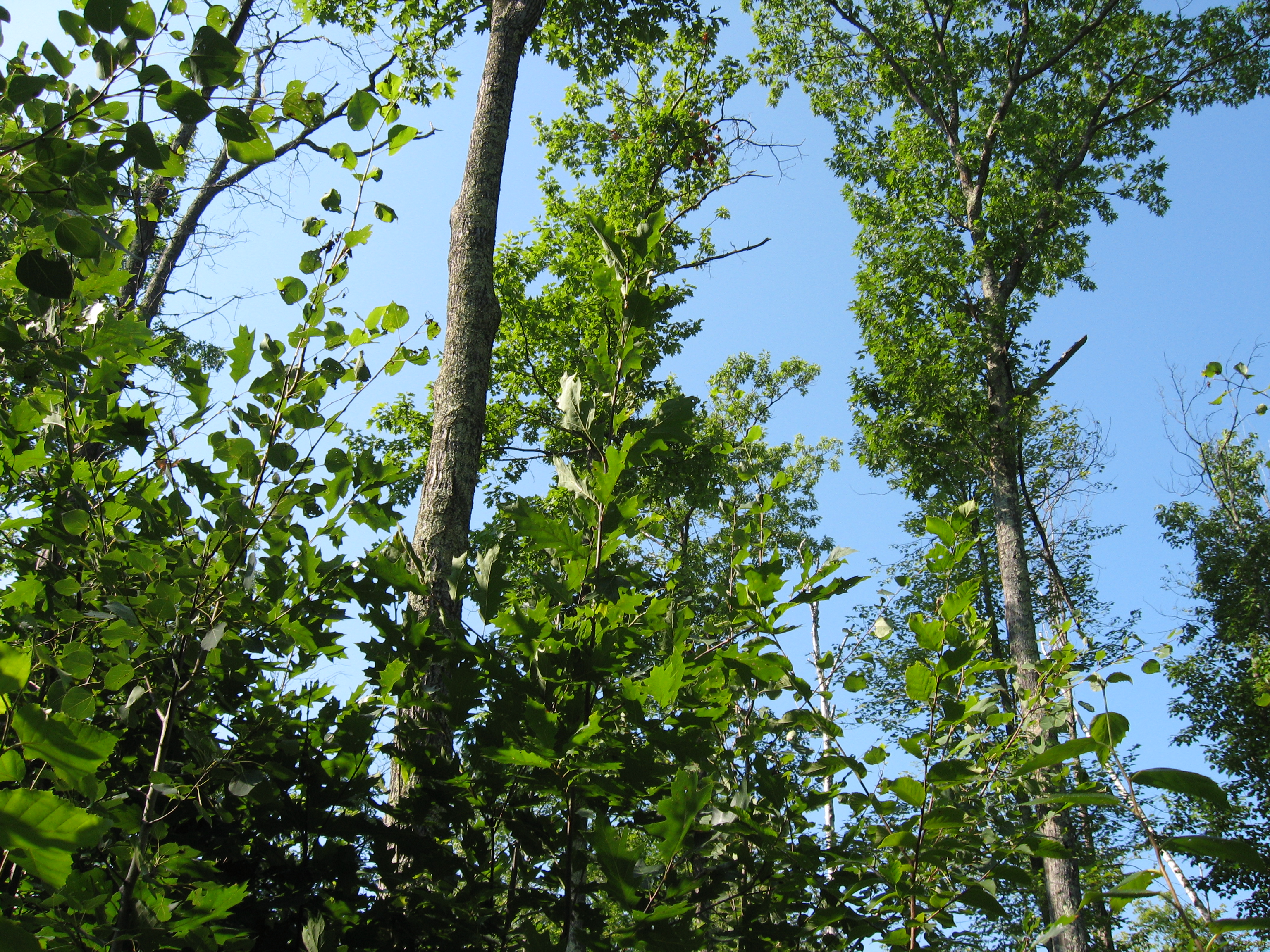
Figure 2: 5 year post-harvest picture of retained overstory oak
Post-treatment assessment
DNR regeneration checks occurred in Stand 1 at one and four years after harvest (Table 2). Red oak numbers were above targets but aspen numbers were higher than desired.
More intensive one year regeneration checks were collected in Stand 2 using size bins to categorize regeneration. Because harvest was staggered over the course of two years, this survey was for the second growing season for the west 1/3 of the stand.
It appears the treatment in Stand 1 more closely emulated a fire disturbance, and the treatment in Stand 2 emulated a wind storm disturbance. Stand 1 has a significantly higher amount of northern red oak and quaking aspen present one year post-harvest. This is most likely from the site scarification creating a suitable seed bed for the oak and also the mortality of shade tolerant advanced regeneration during the harvest.
Stand 2 had a significantly higher amount of sugar maple, basswood, and black ash (mid to high tolerant species) present in the one year regen check. This is most likely due to advance regeneration being protected from mortality during harvest and lack of adequate seed bed for acorn germination. Red oak numbers were significantly lower in Stand 2.
Table 2: Tree regeneration density (avg. stems/acre) 1 and 4 years post-establishment cut for Stand 1 (fall harvest) and 1 year post-establishment cut for Stand 2. Stand 1 had a standard regeneration survey done with no available size data. Stand 2 had regeneration surveys done using size bins (regenerants = less than 1 inch DBH and less than 1 foot tall; seedlings = less than 1 inch DBH and greater than 1 foot tall; saplings = 1-3 inch DBH and small trees = 3-5 inch DBH). Totals for all sizes in Stand 2 are shown for comparison of both stands.
| Stand 1, fall harvest | Stand 1, fall harvest | Stand 2, winter harvest | |||||
| 1 year post-harvest (trees per acre) |
4 years post-harvest (trees per acre) |
1 year post-harvest (trees per acre) |
|||||
| Species | No size data | No size data | All sizes | Regenerants (<1" DBH and <1' tall) |
Seedlings (< 1" DBH and > 1' tall) |
Saplings (1 - 3" DBH) |
Small trees (3 - 5" DBH) |
| Red oak | 807 | 940 | 186 | 143 | 43 | 0 | 0 |
| Basswood | 10 | 93 | 292 | 29 | 257 | 0 | 6 |
| Sugar maple | 385 | 187 | 1688 | 857 | 800 | 11 | 20 |
| Red maple | 240 | 578 | 592 | 429 | 157 | 0 | 6 |
| Paper birch | 461 | 62 | 570 | 270 | 300 | 0 | 0 |
| Yellow birch | 0 | 0 | 14 | 0 | 14 | 0 | 0 |
| Quaking aspen | 1720 | 1875 | 786 | 143 | 643 | 0 | 0 |
| Black ash | 57 | 1030 | 718 | 129 | 586 | 3 | 0 |
| Bur oak | 0 | 15 | 0 | 0 | 0 | 0 | 0 |
| Balsam fir | 0 | 0 | 11 | 0 | 0 | 0 | 11 |
| Ironwood | 0 | 625 | 509 | 71 | 386 | 43 | 9 |
| Total | 3680 | 5405 | 5366 | 2071 | 3186 | 57 | 52 |
Plans for future treatments
Stand 1 is ready for overstory removal with the goal of diminished aspen and allowing red oak regeneration to sprout back from established root systems the year after harvest. A decision will have to be made on Stand 2 regarding acceptable species composition of the future stand. The stand will be adequately stocked but with sugar maple and other shade mid-tolerant to tolerant species. Some form of site scarification (e.g., anchor chain, prescribe burn, fecon head brushing, etc.) could also be conducted on portions of the site in an attempt to establish seed origin oak from the residuals scattered throughout the stand.
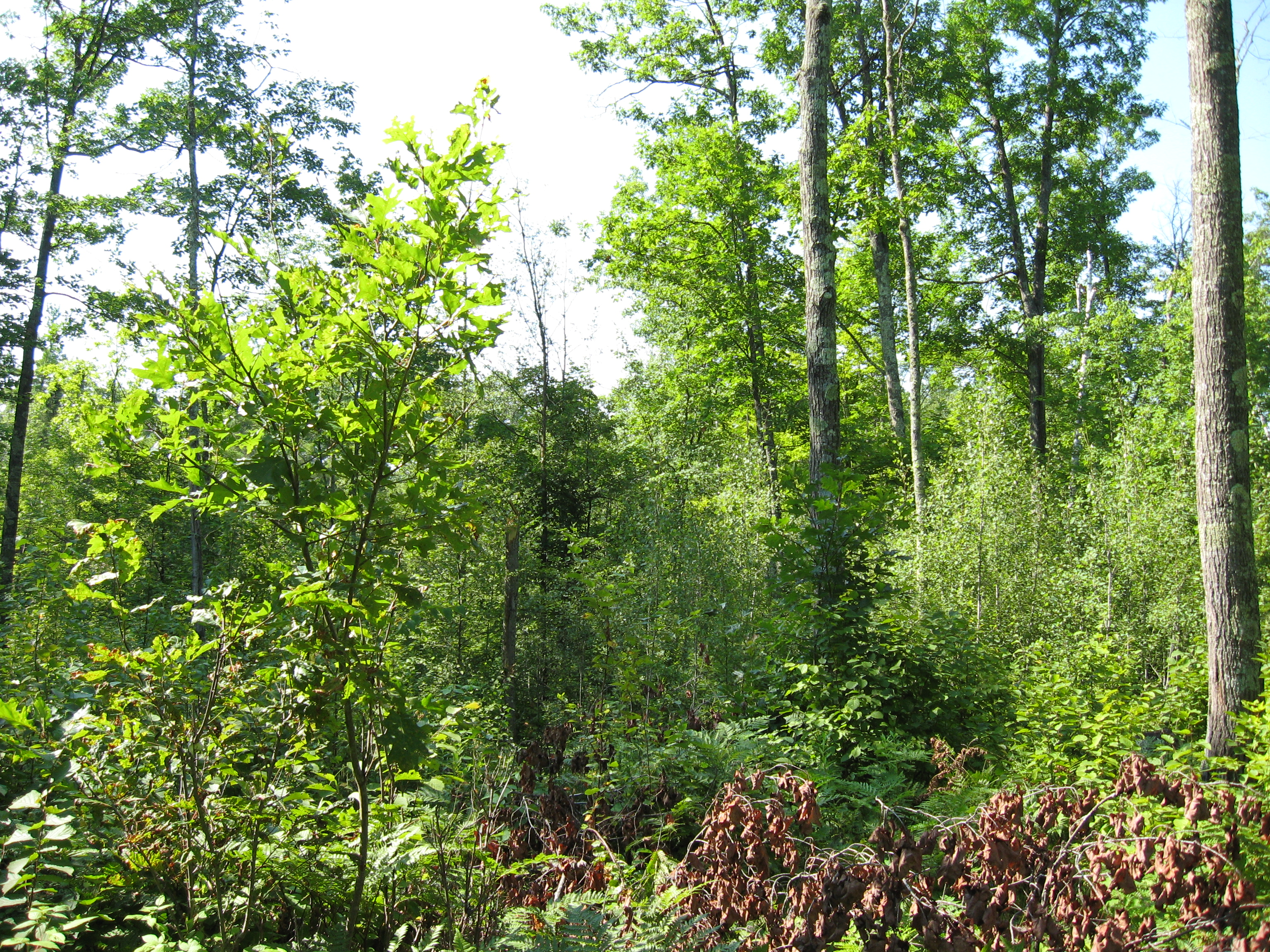
Figure 3: Aspen competition with oak component
Intensive 5-year regeneration checks will be conducted in both stands to compare recruitment of species over the same time period.
Costs and economic considerations
Stand 1- 18 cd/acre of aspen and mixed hardwoods removed in 2012 with a stumpage value of $6,200 ($206/acre). No site preparation or TSI costs for this stand to date.
Stand 2-16 cd/acre of mixed hardwoods removed in 2017 with a stumpage value of $14,211 ($203/acre). No site preparation or TSI costs for the stand to date.
Other notes
This case study was reviewed by MN DNR Silviculture Program Staff Mike Reinikainen on 4/25/2019.
Summary / lessons learned / additional thoughts
Based on what we see from these two stands, if we wish to maintain or increase oak on MHn35 sites, timing and method of harvesting is critical. Some possible solutions may be to require late summer/fall harvest for the initial shelterwood cut, and increase the permit length from 3 years to 5 years. This would increase the chance of encountering an acceptable fall harvest opportunity. If a winter harvest is the only option, piling slash throughout the site could make site prep or planting operations more feasible. Alternatively, prescribed understory burning pre-harvest could be used to decrease advanced regeneration of shade tolerant species. In future oak shelterwoods, increasing retention during the establishment cut to a basal area of 50 square feet per acre might help reduce the amount of aspen suckering post-harvest by increasing shade.
Supplemental content
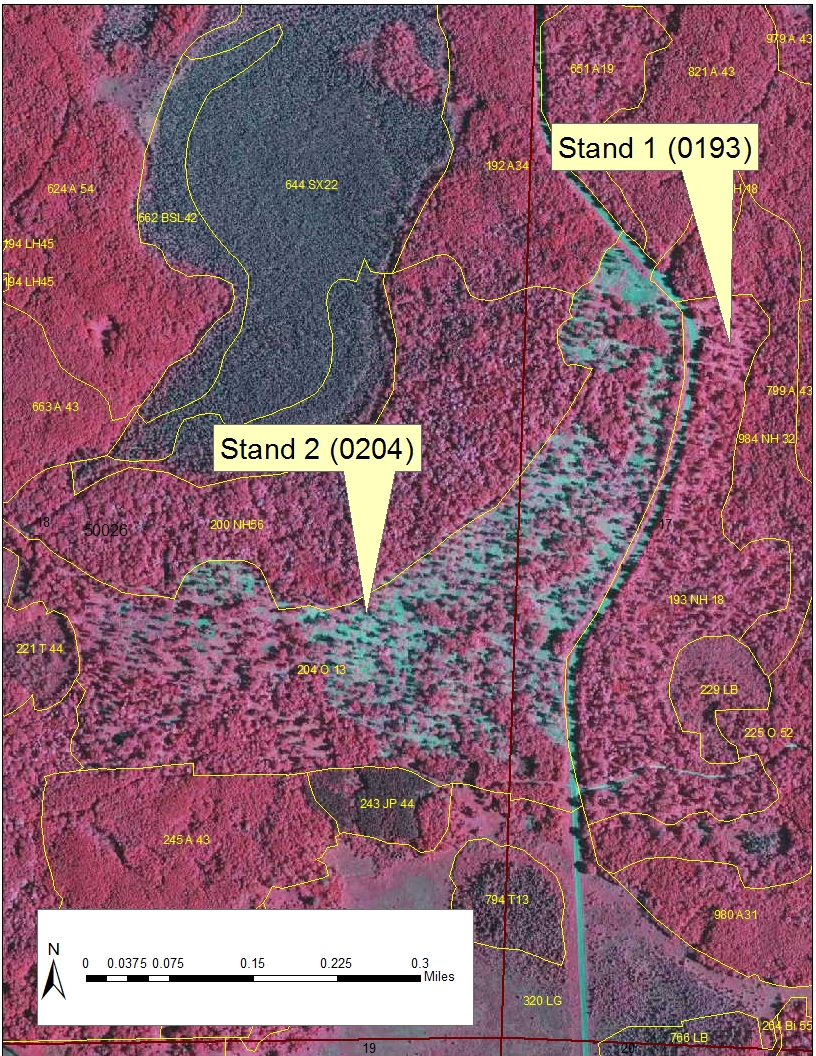
Site map for the case study.
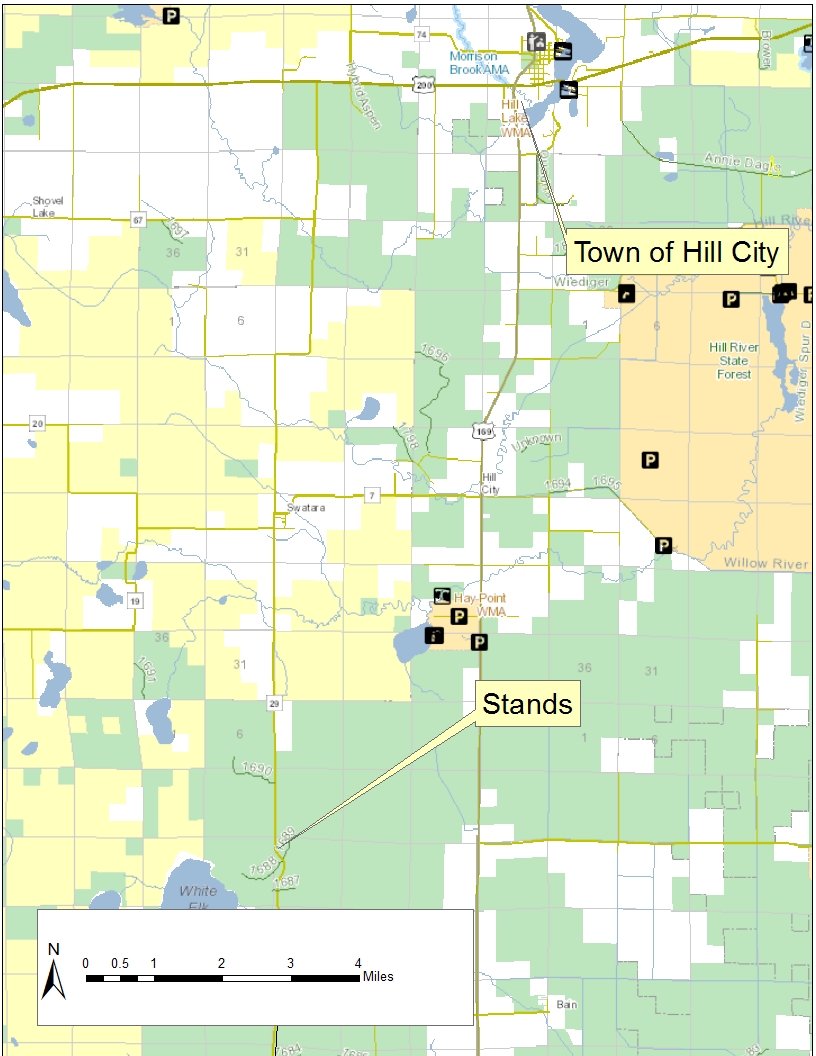
Broader landscape context for the stands.
